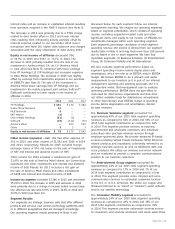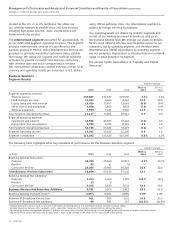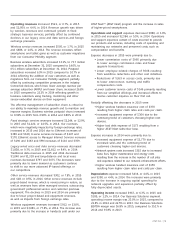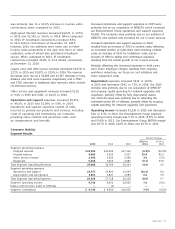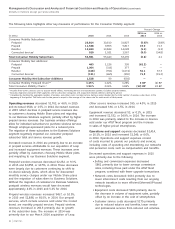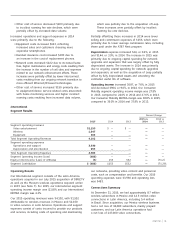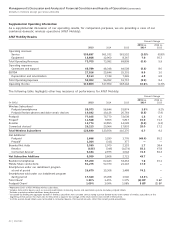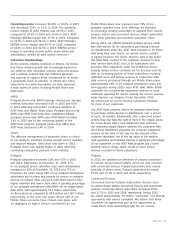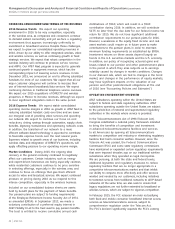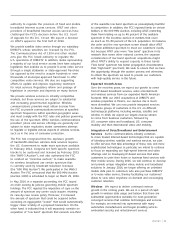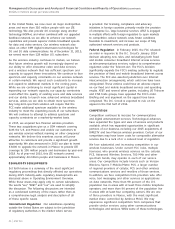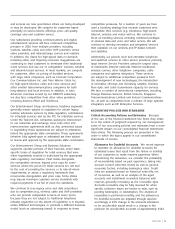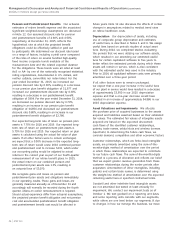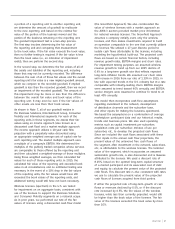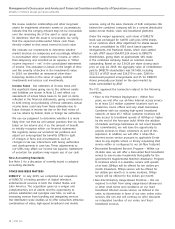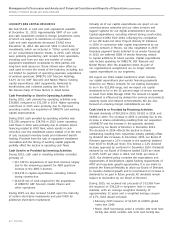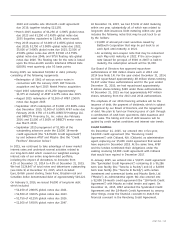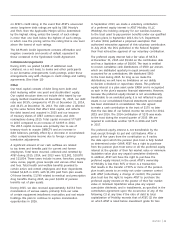AT&T Wireless 2015 Annual Report Download - page 25
Download and view the complete annual report
Please find page 25 of the 2015 AT&T Wireless annual report below. You can navigate through the pages in the report by either clicking on the pages listed below, or by using the keyword search tool below to find specific information within the annual report.
AT&T INC.
|
23
of the available low band spectrum as presumptively harmful
to competition. In addition, the FCC imposed limits on certain
bidders in the 600 MHz Auction, including AT&T, restricting
them from bidding on up to 40percent of the available
spectrum in the incentive auction in markets that cover
as much as 70–80 percent of the U.S. population. On balance,
the order and the new spectrum screen should allow AT&T
to obtain additional spectrum to meet our customers’ needs,
but because AT&T uses more “low band” spectrum in its
network than some other national carriers, the separate
consideration of low band spectrum acquisitions might
affect AT&T’s ability to expand capacity in these bands
(“low band” spectrum has better propagation characteristics
than “high band” spectrum). We seek to ensure that we have
the opportunity, through the auction process and otherwise,
to obtain the spectrum we need to provide our customers
with high-quality service in the future.
Expected Growth Areas
Over the next few years, we expect our growth to come
from IP-based broadband services, video entertainment
and wireless services from our expanded North American
footprint. With our 2015 acquisitions of DIRECTV and
wireless properties in Mexico, our revenue mix is much
more diversified. We can now provide integrated services
to diverse groups of customers in the U.S. on different
technological platforms, including wireless, satellite and
wireline. In 2016, we expect our largest revenue stream
to come from business customers, followed by
U.S. consumer video and broadband, U.S. consumer
mobility and then international video and mobility.
Integration of Data/Broadband and Entertainment
Services As the communications industry continues
to move toward Internet-based technologies that are capable
of blending wireline, satellite and wireless services, we plan
to offer services that take advantage of these new and more
sophisticated technologies. In particular, we intend to continue
to focus on expanding our high-speed Internet and video
offerings and on developing IP-based services that allow
customers to unite their home or business fixed services with
their mobile service. During 2016, we will continue to develop
and provide unique integrated video, mobile and broadband
solutions. In January 2016, we began offering an unlimited
mobile data plan to customers who also purchase DIRECTV
or U-verse video service, thereby facilitating our customers’
desire to view video anywhere on demand and encouraging
customer retention.
Wireless We expect to deliver continued revenue
growth in the coming years. We are in a period of rapid
growth in wireless data usage and believe that there are
substantial opportunities available for next-generation
converged services that combine technologies and services.
For example, we entered into agreements with many
automobile manufacturers and began providing vehicle-
embedded security and entertainment services.
authority to regulate the provision of fixed and mobile
broadband Internet access services. AT&T and other
providers of broadband Internet access services have
challenged the FCC’s decision before the U.S. Court
of Appeals for the D.C.Circuit. We expect a decision
on AT&T’s appeal in the first half of 2016.
We provide satellite video service through our subsidiary
DIRECTV, whose satellites are licensed by the FCC.
The Communications Act of 1934 and other related
acts give the FCC broad authority to regulate the
U.S. operations of DIRECTV. In addition, states representing
a majority of our local service access lines have adopted
legislation that enables us to provide U-verse video service
through a single statewide or state-approved franchise
(as opposed to the need to acquire hundreds or even
thousands of municipal-approved franchises) to offer
competitive video services. We also are supporting
efforts to update and improve regulatory treatment
for retail services. Regulatory reform and passage of
legislation is uncertain and depends on many factors.
We provide wireless services in robustly competitive
markets, but those services are subject to substantial
and increasing governmental regulation. Wireless
communications providers must obtain licenses from
the FCC to provide communications services at specified
spectrum frequencies within specified geographic areas
and must comply with the FCC rules and policies governing
the use of the spectrum. While wireless communications
providers’ prices and service offerings are generally not
subject to state regulation, states sometimes attempt
to regulate or legislate various aspects of wireless services,
such as in the area of consumer protection.
The FCC has recognized that the explosive growth
of bandwidth-intensive wireless data services requires
the U.S.Government to make more spectrum available.
In February2012, Congress set forth specific spectrum
blocks to be auctioned and licensed by February 2015
(the “AWS-3 Auction”), and also authorized the FCC
to conduct an “incentive auction,” to make available
for wireless broadband use certain spectrum that
is currently used by broadcast television licensees
(the “600 MHz Auction”). We participated in the AWS-3
Auction. The FCC announced that the 600MHz Auction
(Auction 1000) is scheduled to begin on March 29, 2016.
In May 2014, in a separate proceeding, the FCC issued
an order revising its policies governing mobile spectrum
holdings. The FCC rejected the imposition of caps on the
amount of spectrum any carrier could acquire, retaining
its case-by-case review policy. Moreover, it increased
the amount of spectrum that could be acquired before
exceeding an aggregation “screen” that would automatically
trigger closer scrutiny of a proposed transaction. On the
other hand, it indicated that it will separately consider an
acquisition of “low band” spectrum that exceeds one-third


